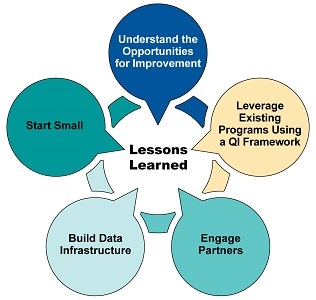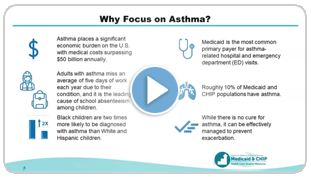Asthma is one of the most common chronic illnesses in the United States, especially among children, and although there is no cure, it can be effectively managed to prevent exacerbation. Roughly 10 percent of children and adults with Medicaid coverage have asthma at some point during their lives. The Centers for Medicare & Medicaid Services (CMS) offers quality improvement (QI) technical assistance to help states increase access to, and use of, asthma control supports among adults and children enrolled in Medicaid and Children’s Health Insurance Program (CHIP).
The technical assistance has two components:
- QI resources to help state Medicaid and CHIP staff and their QI partners get started improving asthma control for their beneficiaries.
- Background materials, including approaches to asthma control and state examples of successful asthma control, developed as part of CMS’s Improving Asthma Control learning collaborative.
For more information on these materials and other QI technical assistance, please email MedicaidCHIPQI@cms.hhs.gov.
Getting Started with QI
Here are some technical assistance tools to help states interested in developing their own asthma control QI projects get started:
- Improving Asthma Control for Medicaid and Children’s Health Insurance Program Beneficiaries: Getting Started on Quality Improvement. This video provides an overview of how Medicaid and CHIP agencies can start a QI project to improve asthma control. The Model for Improvement begins with small tests of change, enabling state teams to “learn their way” toward strong programs and policies.
- Improving Asthma Control Driver Diagram and Change Idea Table. A driver diagram is a visual display of what “drives” or contributes to improvements in asthma control. This example of a driver diagram shows the relationship between the primary drivers (the high-level elements, processes, structures, or norms in the system that must change to improve asthma control) and the secondary drivers (the places, steps in a process, time-bound moments, or norms in which changes are made to spur improvement). The document also includes change idea tables, which contains examples of evidence-based or evidence-informed asthma control QI interventions. The change ideas were tailored for Medicaid and CHIP.
- Improving Asthma Control Measurement Strategy. This measurement strategy provides examples of measures that can be used to monitor asthma control QI projects.
For more information on these materials and other QI technical assistance, please contact MedicaidCHIPQI@cms.hhs.gov.
Improving Asthma Control Learning Collaborative

In 2020, CMS launched the Improving Asthma Control learning collaborative to support state Medicaid and CHIP agencies’ efforts to improve health outcomes among beneficiaries with asthma. The learning collaborative included a webinar series and an affinity group.
The webinar series consisted of presentations from experts in the field and described approaches that states can use to improve asthma control and outcomes. States interested in acting on the concepts and tools introduced through the webinars could participate in an action-oriented affinity group, which helped states design and implement their own QI projects. Results from states that participated in the affinity group can be found in the highlights brief and in the state spotlights webinar.
Webinar Series
Webinar: "State Spotlights: Improving Asthma Control"
This webinar spotlighted QI projects from Texas and California, highlighting the state teams' strategies, partnerships, and lessons learned through work supported by CMS in the Improving Asthma Control affinity group. From June 2020 through June 2022, CMS provided eight state Medicaid and CHIP teams and their QI partners in this affinity group with information, tools, and expert support to improve asthma control and outcomes for Medicaid and CHIP beneficiaries.
- State Spotlights: Improving Asthma Control (video, transcript) (February 2023)
Webinar: "The Role of Medicaid and CHIP in Improving Asthma Control"
This webinar described the importance of population-level asthma control, including clinical, environmental, and community-based interventions, for ensuring health and well-being and for reducing health care expenditures. Dr. Joy Hsu introduced the Centers for Disease Control and Prevention’s EXHALE framework of evidence-based strategies to control asthma, improve outcomes, and demonstrate a positive return on investment.
This webinar also introduced tools to translate data findings into QI activities for state Medicaid and CHIP agencies. Natasha Reese-McLaughlin from Mathematica presented a driver diagram showing the array of primary and secondary drivers and change activities that states can use to improve asthma outcomes. The diagram included evidence-based interventions to address high-priority drivers, including increasing adherence to asthma medication, promoting guideline-based clinical care, reducing exposure to home- and school-based triggers, and facilitating cross-sector partnerships.
During the Q&A session, presenters discussed coverage gaps for Medicaid and managed care organizations, best practices for reducing respiratory infections, ensuring medication adherence through shared clinical decision-making, and collaborating with providers in QI work.
- The Role of Medicaid and CHIP in Improving Asthma Control (audio, transcript) (October 2019)
Webinar: "Using Data to Improve Asthma Control: Asthma Quality Measures"
This webinar focused on how states can use data from quality measures and surveillance sources to drive improvements in asthma control. Natasha Reese-McLaughlin from Mathematica introduced the Plan-Do-Study-Act (PDSA) framework, which involves implementing iterative cycles of small tests of change to drive QI.
Stakeholders from California, New York, Rhode Island, and Utah then participated in a panel discussion on using asthma control measures and data tools in QI projects, including selecting the right measures to monitor QI, overcoming measure challenges, stratifying data to monitor impact and identify unmet needs, and setting benchmarks. State panelists offered varied insights based on their unique asthma QI projects, including the landscape of asthma surveillance data; ways to use the data for long-term improvement and spread; the importance of engaging stakeholders at the state agency, Medicaid, managed care organization, and provider levels in QI projects; and the potential return-on-investment of several programs designed to improve asthma measures and reduce health care expenditures.
During the Q&A portion of the webinar, panelists offered insights into measures most critical for collaborating with distinct stakeholder groups.
- Using Data to Improve Asthma Control: Asthma Quality Measures (audio, transcript) (November 2019)
Webinar: "Models of Asthma Care: Successful State Case Studies"
Three states—Missouri, Maryland, and California—shared best practices from their asthma QI programs, noting program similarities such as their focus on environmental and clinical outcomes, reimbursement pathways, cross-agency partnerships, and data use. Each state also tailored QI projects to its population’s needs and state resource capacity.
Missouri discussed its use of a state plan amendment to reimburse providers for home environmental assessments and how its Health Home program increased provider demand for asthma interventions. The state also shared how it worked with its managed care plans by aligning key performance indicators and coverage requirements with the request for proposals.
Maryland’s QI project provided cross-agency funding to local health departments to hire case managers and community health workers to conduct home visits and environmental case management. This helped improve asthma-induced symptoms and increased the use of rescue inhalers.
California shared its “train-the-trainer” program, designed to improve patient outcomes and dissemination processes for asthma action plans. The state used QI tools, including a process flow map and PDSA cycles, and its partnership with a community health center to advance the program.
- Models of Asthma Care: Successful State Case Studies (audio, transcript) (December 2019)
Webinar: "Improving Asthma Control Affinity Group Q&A"
The final webinar served as an introduction to the Improving Asthma Control affinity group, including the structure of the affinity group, the Expression of Interest (EOI) requirements, and the expected commitment from each participating state team.


